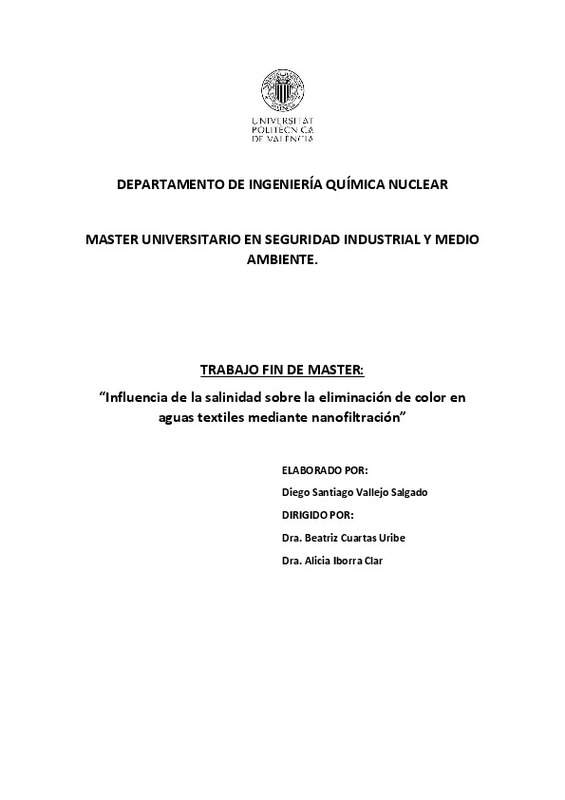JavaScript is disabled for your browser. Some features of this site may not work without it.
Buscar en RiuNet
Listar
Mi cuenta
Estadísticas
Ayuda RiuNet
Admin. UPV
Influencia de la salinidad sobre la eliminación de color en aguas textiles mediante nanofiltración
Mostrar el registro sencillo del ítem
Ficheros en el ítem
| dc.contributor.advisor | Iborra Clar, Alicia
|
es_ES |
| dc.contributor.advisor | Cuartas Uribe, Beatriz Elena
|
es_ES |
| dc.contributor.author | Vallejo Salgado, Diego Santiago
|
es_ES |
| dc.date.accessioned | 2018-10-23T06:55:12Z | |
| dc.date.available | 2018-10-23T06:55:12Z | |
| dc.date.created | 2018-07-19 | es_ES |
| dc.date.issued | 2018-10-23 | es_ES |
| dc.identifier.uri | http://hdl.handle.net/10251/111098 | |
| dc.description.abstract | La industria textil es uno de los sectores más antiguos y complejos dentro de las industrias manufactureras, este sector consta de numerosos subsectores que abarcan todo el ciclo de producción, desde las materias primas que en su mayoría son las fibras artificiales y los productos semiprocesados, hasta llegar a los productos finales. El principal problema ambiental que tiene el sector textil radica en las aguas residuales que genera y en la carga química que las mismas contienen, y también los problemas que puede causar un agua con alta carga de color. Por esta razón el presente trabajo se enfoca en el tratamiento de aguas residuales que poseen gran cantidad de color y conductividad mediante un proceso de membranas de Nanofiltración. Se realizó un proceso experimental en el cual se trata un efluente sintético que simula a un tipo agua residual textil, el cual tiene una concentración fija de colorante Remazol azul, y una variación de concentración de sal. Los resultados de los ensayos indican que la membrana de NF tiene gran capacidad de remoción del colorante de un 99%, y que no se ve afectado por la presencia de la sal en ningún momento, la remoción de la sal es de un 25% aproximadamente, por lo que puede decirse que la membrana de NF se puede utilizar para lograr una separación entre el colorante y las sales presentes en un agua residual de la industria textil, pudiendo sacar grandes beneficios como por ejemplo la recuperación de un colorante o la reutilización de un efluente. | es_ES |
| dc.description.abstract | The textile industry is one of the oldest and most complex sectors, it consists of numerous subsectors that cover the entire production cycle, from raw materials that are mostly artificial fibers and semi-processed products, to final products. The main environmental problem that the textile sector has is the wastewater that it generates and the chemical load that it contains, and the problems that a water with a high color load can cause. For this reason, the present work focuses on the treatment of wastewater that has a large amount of color and conductivity through a Nanofiltration membrane process. An experimental process was carried out in which a synthetic effluent is treated that simulates a wastewater textile type, which has a fixed concentration of blue Remazol dye, and a variation of salt concentration. The results of the tests indicate that the NF membrane has a great 99% dye removal capacity, and that it is not affected by the presence of the salt at any time, the removal of the salt is approximately 25%, so it can be said that the membrane of NF can be used to achieve a separation between the dye and the salts present in a wastewater of the textile industry, being able to obtain great benefits such as the recovery of a dye or the reuse of an effluent. | en_EN |
| dc.language | Español | es_ES |
| dc.publisher | Universitat Politècnica de València | es_ES |
| dc.rights | Reconocimiento - No comercial - Sin obra derivada (by-nc-nd) | es_ES |
| dc.subject | agua residual textil | es_ES |
| dc.subject | nanofiltración | es_ES |
| dc.subject | salinidad | es_ES |
| dc.subject | eliminación de color. | es_ES |
| dc.subject | Textile wastewater | en_EN |
| dc.subject | nanofiltration | en_EN |
| dc.subject | dye removal | en_EN |
| dc.subject.classification | INGENIERIA QUIMICA | es_ES |
| dc.subject.other | Máster Universitario en Seguridad Industrial y Medio Ambiente-Màster Universitari en Seguretat Industrial i Medi Ambient | es_ES |
| dc.title | Influencia de la salinidad sobre la eliminación de color en aguas textiles mediante nanofiltración | es_ES |
| dc.type | Tesis de máster | es_ES |
| dc.rights.accessRights | Abierto | es_ES |
| dc.contributor.affiliation | Universitat Politècnica de València. Departamento de Ingeniería Química y Nuclear - Departament d'Enginyeria Química i Nuclear | es_ES |
| dc.description.bibliographicCitation | Vallejo Salgado, DS. (2018). Influencia de la salinidad sobre la eliminación de color en aguas textiles mediante nanofiltración. http://hdl.handle.net/10251/111098 | es_ES |
| dc.description.accrualMethod | TFGM | es_ES |
| dc.relation.pasarela | TFGM\87755 | es_ES |






